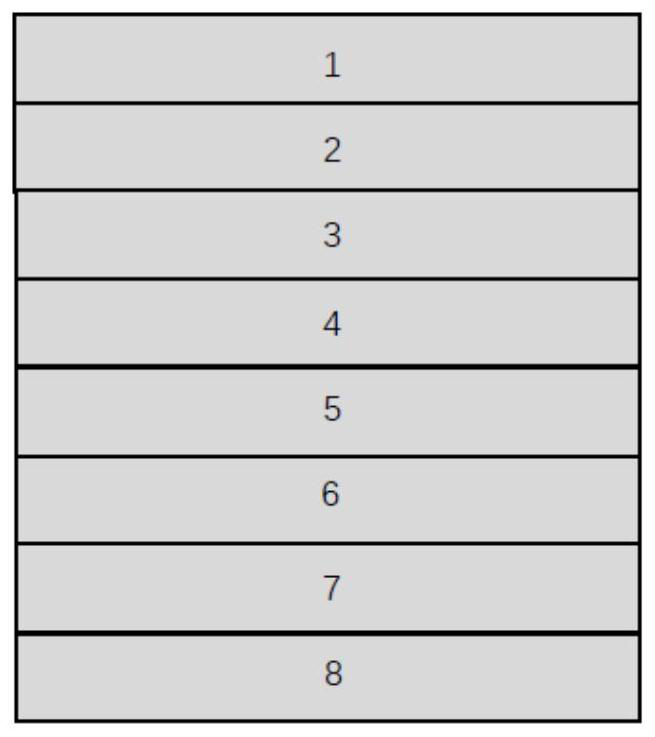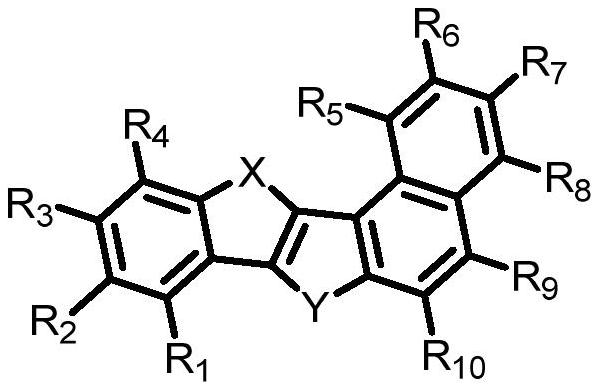Blue light host material and blue light emitting device
A blue-light host material and host material technology, applied in luminescent materials, electric solid-state devices, semiconductor devices, etc., can solve the problems of lack of high efficiency and long life, and achieve high thermal stability, large energy band width, and high fluorescence quantum production rate effect
- Summary
- Abstract
- Description
- Claims
- Application Information
AI Technical Summary
Problems solved by technology
Method used
Image
Examples
Embodiment 1
[0036] This example provides a blue light host material, which is denoted as compound 72, and its synthesis route is as follows:
[0037]
[0038] The synthetic method of compound 72 specifically comprises the following steps:
[0039] Synthesis of intermediate M1: 5-bromo-3-nitrobenzothiophene (7.71g, 30mmol), 3-bromo-1-hydroxynaphthalene (10.0g, 45mmol), anhydrous potassium carbonate (2.07g, 15mmol) With 100mL of absolute ethanol, the temperature was raised to reflux and stirred for 24 hours, cooled to room temperature, and the crude product was purified by silica gel column chromatography (petroleum ether / ethyl acetate was 5 / 1 (volume ratio)) to obtain M1 with a yield of 40%. 1 H NMR (500MHz, Chloroform-d) δ8.23(dd, J=7.2, 1.8Hz, 1H), 8.04–7.40(m, 3H), 7.89(d, J=7.5Hz, 1H), 7.54(dd, J=7.5, 1.6Hz, 1H), 7.50–7.40(m, 2H).
[0040] Synthesis of intermediate M2: M1 (25.8g, 60mmol), 2-boronic naphthalene (10.32g, 60mmol), tetrakistriphenylphosphine palladium (0.2g) were diss...
Embodiment 2
[0043] This example provides a blue light host material, which is denoted as compound 75, and its synthesis route is as follows:
[0044]
[0045] The synthesis of intermediate M1 is shown in Example 1.
[0046] Synthesis of intermediate M3: M1 (25.8g, 60mmol), 2-boronic naphthalene (10.32g, 60mmol), tetrakistriphenylphosphine palladium (0.2g) were dissolved in toluene / ethanol / water (200mL / 40mL / 40mL). After stirring at 85°C for 15 hours, the mixture was filtered, extracted with chloroform, and the aqueous phase was extracted three times with 60 mL of ethyl acetate. The organic phases were combined and dried over anhydrous magnesium sulfate. The crude product was subjected to silica gel column chromatography (petroleum ether / ethyl acetate 5 / 1 (volume ratio)) to obtain M3 with a yield of 32%. 1 H NMR (500MHz, Chloroform-d) δ8.13–8.05 (m, 3H), 8.00 (td, J = 7.4, 1.7Hz, 2H), 7.88 (ddt, J = 7.7, 6.0, 2.0Hz, 2H), 7.79 (dd, J=7.5, 1.5Hz, 1H), 7.70 (t, J=1.6Hz, 1H), 7.54–7.43 (...
Embodiment 3
[0049] This example provides a blue light host material, which is denoted as compound 111, and its synthesis route is as follows:
[0050]
[0051] The synthetic method of compound 111 specifically comprises the following steps:
[0052] The synthesis of intermediate M1 is shown in Example 1.
[0053] The synthesis of intermediate M2 is shown in Example 1.
[0054] Synthesis of compound 111: M2 (28.7g, 60mmol), deuterated phenylboronic acid (7.32g, 60mmol), tetrakistriphenylphosphine palladium (0.2g) were dissolved in toluene / ethanol / water (300mL / 60mL / 60mL). After stirring at 85°C for 15 hours, the mixture was filtered, extracted with chloroform, and the aqueous phase was extracted three times with 100 mL of ethyl acetate. The organic phases were combined and dried over anhydrous magnesium sulfate. The crude product was subjected to silica gel column chromatography (petroleum ether / ethyl acetate 5 / 1 (volume ratio)) to obtain compound 111 with a yield of 86%. 1 H NMR (5...
PUM
| Property | Measurement | Unit |
|---|---|---|
| full width at half maximum | aaaaa | aaaaa |
| current efficiency | aaaaa | aaaaa |
Abstract
Description
Claims
Application Information
 Login to View More
Login to View More - R&D
- Intellectual Property
- Life Sciences
- Materials
- Tech Scout
- Unparalleled Data Quality
- Higher Quality Content
- 60% Fewer Hallucinations
Browse by: Latest US Patents, China's latest patents, Technical Efficacy Thesaurus, Application Domain, Technology Topic, Popular Technical Reports.
© 2025 PatSnap. All rights reserved.Legal|Privacy policy|Modern Slavery Act Transparency Statement|Sitemap|About US| Contact US: help@patsnap.com



